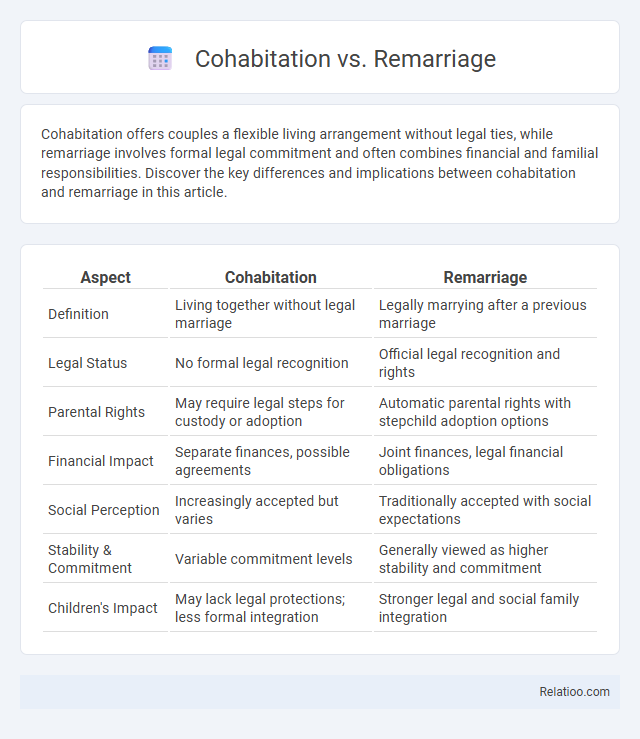Cohabitation offers couples a flexible living arrangement without legal ties, while remarriage involves formal legal commitment and often combines financial and familial responsibilities. Discover the key differences and implications between cohabitation and remarriage in this article.
Table of Comparison
| Aspect | Cohabitation | Remarriage |
|---|---|---|
| Definition | Living together without legal marriage | Legally marrying after a previous marriage |
| Legal Status | No formal legal recognition | Official legal recognition and rights |
| Parental Rights | May require legal steps for custody or adoption | Automatic parental rights with stepchild adoption options |
| Financial Impact | Separate finances, possible agreements | Joint finances, legal financial obligations |
| Social Perception | Increasingly accepted but varies | Traditionally accepted with social expectations |
| Stability & Commitment | Variable commitment levels | Generally viewed as higher stability and commitment |
| Children's Impact | May lack legal protections; less formal integration | Stronger legal and social family integration |
Introduction to Cohabitation and Remarriage
Cohabitation involves living together as a couple without formalizing the relationship through legal marriage, often serving as a trial phase before making a long-term commitment. Remarriage occurs when an individual legally marries again after a previous marriage, bringing complexities related to blended families, inheritance, and legal responsibilities. Understanding the distinctions between cohabitation and remarriage helps you navigate relationship dynamics, legal rights, and financial planning effectively.
Legal Differences Between Cohabitation and Remarriage
Legal differences between cohabitation and remarriage primarily center on property rights, inheritance, and spousal benefits. In most jurisdictions, remarried couples enjoy automatic legal protections, including joint property ownership, tax benefits, and survivor rights, while cohabiting partners often lack these unless formal agreements are established. Understanding these distinctions helps you protect your rights and secure your financial and legal interests effectively.
Social Acceptance and Cultural Perspectives
Social acceptance of cohabitation varies widely across cultures, often being more accepted in Western societies where individual freedom and non-traditional relationship structures are emphasized. Remarriage is generally embraced across many cultures due to established social and religious frameworks that support family continuity and stability. Repartnering after separation or widowhood is gaining acceptance globally, yet cultural perspectives influence the level of support or stigma, with some societies prioritizing familial legacy and others endorsing personal happiness and autonomy.
Financial Implications: Assets, Debts, and Taxes
Cohabitation, remarriage, and repartnering each carry distinct financial implications impacting your assets, debts, and taxes. In remarriage, legal rights to spousal assets and debts officially merge, influencing estate planning and tax benefits such as filing jointly. Cohabitation and repartnering often lack automatic legal protections, exposing you to individual liability for debts and requiring explicit agreements to manage shared assets and optimize tax obligations.
Impact on Children and Family Dynamics
Cohabitation, remarriage, and repartnering each uniquely influence children's emotional well-being and family dynamics, with remarriage often providing more stability through legal and social recognition. Cohabitation may introduce ambiguity in family roles, potentially causing adjustment challenges for children, while repartnering without marriage can blur parental boundaries but allows more flexible family structures. Research highlights that clear communication and consistent parenting practices are critical in mitigating negative effects on children regardless of the family arrangement.
Emotional Considerations and Relationship Stability
Cohabitation often involves lower emotional commitment and can lead to higher relationship instability compared to remarriage, which typically signifies a deeper emotional investment and greater legal and social commitment. Repartnering may offer emotional renewal but can carry residual challenges from previous relationships affecting stability. Your emotional well-being and long-term relationship stability are influenced by how you navigate commitment levels, trust, and past relationship experiences in these different relationship forms.
Religious and Moral Viewpoints
Religious viewpoints often regard remarriage after divorce as permissible within certain doctrinal boundaries, whereas cohabitation without marriage frequently faces criticism for lacking sacred commitment and violating traditional moral values. Moral perspectives emphasize the sanctity of marriage as a covenant, typically viewing remarriage as a restoration of social and spiritual order, while repartnering through non-marital cohabitation challenges conventional norms and may be seen as undermining family structure. Various faith traditions articulate distinct teachings: for example, Catholicism strictly opposes cohabitation without marriage and allows remarriage only after annulment, while some Protestant denominations adopt more lenient stances, reflecting evolving interpretations of scripture and morality.
Rights and Responsibilities of Partners
Cohabitation, remarriage, and repartnering each involve distinct legal rights and responsibilities that affect property, inheritance, and financial support. You may not automatically receive spousal benefits or legal protections in cohabitation, whereas remarriage typically grants partners comprehensive rights under family law, including community property and spousal support. Repartnering after divorce can require legal agreements to clarify responsibilities and protect rights, as default laws vary by jurisdiction and may not fully recognize non-marital partnerships.
Long-Term Outcomes: Statistics and Trends
Long-term outcomes show cohabitation often leads to higher separation rates compared to remarriage, with approximately 40% of cohabiting couples splitting within five years versus 25% of remarried couples. Repartnering after divorce tends to improve emotional well-being but may still carry a 30% risk of subsequent separation, highlighting the complexity of blended family dynamics. Understanding these trends helps you make informed decisions about relationship stability and future planning.
Choosing What’s Best: Factors to Consider
Choosing between cohabitation, remarriage, or repartnering involves evaluating your emotional readiness, financial stability, and long-term relationship goals. Understanding legal implications, such as property rights and inheritance, plays a crucial role in your decision-making process. Prioritize communication and alignment with your partner to ensure that your choice supports your personal happiness and future security.

Infographic: Cohabitation vs Remarriage
 relatioo.com
relatioo.com